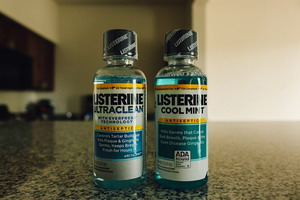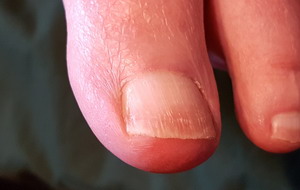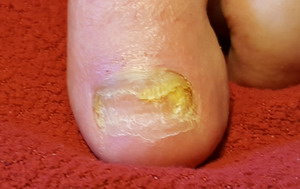 One of the toughest conditions I have come across is toenail fungus. Patients I have had have been fighting this for years. Some of the drugs that doctors try to prescribe for this are truly scary; very dangerous. And even with these super powerful drugs, the fungus persists. A couple of years ago my sweetie, Ellen, contracted toenail fungus on her big toe on the side of her stroke. This was not surprising as the stroke significantly diminished the circulation in that leg. Poor circulation is one condition that sets you up for toenail fungus. What else sets you up?
One of the toughest conditions I have come across is toenail fungus. Patients I have had have been fighting this for years. Some of the drugs that doctors try to prescribe for this are truly scary; very dangerous. And even with these super powerful drugs, the fungus persists. A couple of years ago my sweetie, Ellen, contracted toenail fungus on her big toe on the side of her stroke. This was not surprising as the stroke significantly diminished the circulation in that leg. Poor circulation is one condition that sets you up for toenail fungus. What else sets you up?
What conditions support fungal growth?
Dark
Dirty
Damp
Warm
Acid
Sugar
Poor circulation
 The first four are common to all sorts of fungi. When you go out looking for mushrooms and edible fungi in the forest, those are precisely the environments they love. Foot fungus is the same. Bright sunlight inhibits fungal growth. Since fungi eat dead matter, dirty areas are usually full of dead stuff to feed the fungus. That is why your toes are an ideal environment for fungal growth as there is lots of dead skin to feed on. Toe fungus even eats the stuff that the inside of your shoe is made from. Shoes provide excellent protection from the sun to keep the fungus happy while it is munching on your foot.
The first four are common to all sorts of fungi. When you go out looking for mushrooms and edible fungi in the forest, those are precisely the environments they love. Foot fungus is the same. Bright sunlight inhibits fungal growth. Since fungi eat dead matter, dirty areas are usually full of dead stuff to feed the fungus. That is why your toes are an ideal environment for fungal growth as there is lots of dead skin to feed on. Toe fungus even eats the stuff that the inside of your shoe is made from. Shoes provide excellent protection from the sun to keep the fungus happy while it is munching on your foot.
 Fungi love moisture, just like most plants. Since our feet sweat a good deal and shoes generally don’t admit as much air as normal clothing, the inside of our shoes are pretty moist usually. One of the benefits of the barefoot shoes I wear is that they are made from loose fabric that breaths just like clothes. With slowed evaporation in the shoes, the area stays warmer which the fungi also love. Our skin is normally acidic, about 5.5 (7 is neutral, and lower is more acidic). Our toes are even more acidic, with the nails being 4.13. Fungi likes this and this is part of the reason why the nails are such a choice growing ground.
Fungi love moisture, just like most plants. Since our feet sweat a good deal and shoes generally don’t admit as much air as normal clothing, the inside of our shoes are pretty moist usually. One of the benefits of the barefoot shoes I wear is that they are made from loose fabric that breaths just like clothes. With slowed evaporation in the shoes, the area stays warmer which the fungi also love. Our skin is normally acidic, about 5.5 (7 is neutral, and lower is more acidic). Our toes are even more acidic, with the nails being 4.13. Fungi likes this and this is part of the reason why the nails are such a choice growing ground.
 The last two are most frequently seen in diabetics – high blood sugar and poor circulation as a result. This is why nail fungus is so common in diabetics. The problem here is that almost three-fourths of Americans have some level of blood sugar problems. High blood sugar blocks circulation, especially long distances from the heart (like the toes). Poor circulation keeps the white blood cells from getting to the area to fight the fungus. Plus, fungus loves to eat sweets. So high sugar levels feed the fungus.
The last two are most frequently seen in diabetics – high blood sugar and poor circulation as a result. This is why nail fungus is so common in diabetics. The problem here is that almost three-fourths of Americans have some level of blood sugar problems. High blood sugar blocks circulation, especially long distances from the heart (like the toes). Poor circulation keeps the white blood cells from getting to the area to fight the fungus. Plus, fungus loves to eat sweets. So high sugar levels feed the fungus.
Okay, so now we have a handle on what we need to shift to make the toe environment unfriendly to fungus:

Fight the dark by exposing your feet to sunlight every day.
Fight the dirt with serious scrubbing of your feet every day.
Fight the dampness by drying your feet after you bathe or shower, wearing socks that wick moisture away, and footwear that allows for good air circulation.
Fight the warmth by getting your feet out of shoes as much as possible.
Fight the acid with foot soaks in Epsom salts, tea tree oil, and baking soda.
Fight the sugar by eating a keto diet – no carbs or sugars.
Fight the poor circulation with exercise, vibration plates, carnosine, alpha-lipoic acid, niacin, foot massage, and foot soaks.
 All these home care steps are important steps in treating a case of toenail fungus. For some people, this will be very important as there is a genetic susceptibility factor. If your parents have toenail fungus, you are more likely to get it as well. Toenail fungus becomes more and more common as you get older. By age 70, 50% of folks end up with toenail fungus. What other preventative stuff can we do? Keep toenails properly trimmed and use disinfected pedicure tools. Don’t wear nylons or cotton socks as they do not encourage evaporation of moisture. Don’t use nail polish on a toenail suspected of having fungus. Be wary of public showers as fungus persists for months in the environment – wear shower shoes. If your feet sweat a lot, change your socks more than once during the day. Alternate which shoes you wear and spray an anti-fungal agent into the pair you are not wearing that day.
All these home care steps are important steps in treating a case of toenail fungus. For some people, this will be very important as there is a genetic susceptibility factor. If your parents have toenail fungus, you are more likely to get it as well. Toenail fungus becomes more and more common as you get older. By age 70, 50% of folks end up with toenail fungus. What other preventative stuff can we do? Keep toenails properly trimmed and use disinfected pedicure tools. Don’t wear nylons or cotton socks as they do not encourage evaporation of moisture. Don’t use nail polish on a toenail suspected of having fungus. Be wary of public showers as fungus persists for months in the environment – wear shower shoes. If your feet sweat a lot, change your socks more than once during the day. Alternate which shoes you wear and spray an anti-fungal agent into the pair you are not wearing that day.
 An odd preventative you might not think of is protecting your toes and nails from injury. An injured toenail is very susceptible to infection from fungus. This issue lasts a long time because toenails grow so slowly. It can take a toenail an entire year to replace itself. This has to be kept in mind if you have a toe that is infected with fungus. Even if you use an effective remedy, it can take up to a year for a healthy toenail to fully grow in.
An odd preventative you might not think of is protecting your toes and nails from injury. An injured toenail is very susceptible to infection from fungus. This issue lasts a long time because toenails grow so slowly. It can take a toenail an entire year to replace itself. This has to be kept in mind if you have a toe that is infected with fungus. Even if you use an effective remedy, it can take up to a year for a healthy toenail to fully grow in.
 If you have an overt fungus infection of a toenail, there are a number of treatments available to apply to the infected area. The medical drugs that you either take orally or apply directly to the fungus are quite toxic, so you might want to think twice before going down that route. The internet is full of remedies, which many of my patients have tried over the years with varying amounts of success. A favorite is to soak the toes in original style Listerine mouth wash. This is because the thyme oil in Listerine is a powerful antiseptic.
If you have an overt fungus infection of a toenail, there are a number of treatments available to apply to the infected area. The medical drugs that you either take orally or apply directly to the fungus are quite toxic, so you might want to think twice before going down that route. The internet is full of remedies, which many of my patients have tried over the years with varying amounts of success. A favorite is to soak the toes in original style Listerine mouth wash. This is because the thyme oil in Listerine is a powerful antiseptic.
 Almost a year ago we started treating Ellen’s toenail fungal infection. We were doing most of the stuff listed earlier as well as using thyme oil and tea tree oil. This seemed to be helping, but eventually, her entire nail fell off. As a new nail started growing back in, the fungus reappeared under the new nail as it was growing out. Then one day I was searching through articles on fungal infections on PubMed (https://pubmed.ncbi.nlm.nih.gov) when I came across a single case history write-up of an experimental treatment for toenail fungus. The doctor that submitted the paper noted that this was a one-off trial and was simply hoping someone else would follow up with a study of this. What he did was create a mixture of povidone iodine and DMSO with which to treat the area. Iodine is a super powerful anti-viral, anti-fungal, and anti-bacterial. That is why they paint surgical skin areas with it before cutting into a patient. The issue with toenails is the nail protects the fungus from the outside world. DMSO is an organic solvent that will carry the iodine through the nail bed down to where the fungus lives. The doctor reported a complete resolution of the nail fungus with this treatment.
Almost a year ago we started treating Ellen’s toenail fungal infection. We were doing most of the stuff listed earlier as well as using thyme oil and tea tree oil. This seemed to be helping, but eventually, her entire nail fell off. As a new nail started growing back in, the fungus reappeared under the new nail as it was growing out. Then one day I was searching through articles on fungal infections on PubMed (https://pubmed.ncbi.nlm.nih.gov) when I came across a single case history write-up of an experimental treatment for toenail fungus. The doctor that submitted the paper noted that this was a one-off trial and was simply hoping someone else would follow up with a study of this. What he did was create a mixture of povidone iodine and DMSO with which to treat the area. Iodine is a super powerful anti-viral, anti-fungal, and anti-bacterial. That is why they paint surgical skin areas with it before cutting into a patient. The issue with toenails is the nail protects the fungus from the outside world. DMSO is an organic solvent that will carry the iodine through the nail bed down to where the fungus lives. The doctor reported a complete resolution of the nail fungus with this treatment.
 I immediately ordered the necessary ingredients and made up my own batch. We painted this on Ellen’s toenail every evening for about 6 weeks and amazingly her toenail fungus was gone. Here are the pictures to show the results! It has been about 6 months now and the nail has fully grown back out. It is looking great now. We still give it a treatment about once a week as a preventative measure, but so far things are looking good. Most povidone-iodine comes as a 10% solution, which I mixed 50-50 with 99% medical-grade DMSO. This closely duplicates the solution reported in the literature. So, this replicates the success of the report on PubMed. This does not mean that it will work for you. Before I could say that, there would have to be a double-blinded study with at least 500 cases. Anything less would still be interesting but not any level of proof. But if you would like to try it, great! I am making up some bottles of the solution to put in the office in bottles with nail brushes inside them. That makes application much easier.
I immediately ordered the necessary ingredients and made up my own batch. We painted this on Ellen’s toenail every evening for about 6 weeks and amazingly her toenail fungus was gone. Here are the pictures to show the results! It has been about 6 months now and the nail has fully grown back out. It is looking great now. We still give it a treatment about once a week as a preventative measure, but so far things are looking good. Most povidone-iodine comes as a 10% solution, which I mixed 50-50 with 99% medical-grade DMSO. This closely duplicates the solution reported in the literature. So, this replicates the success of the report on PubMed. This does not mean that it will work for you. Before I could say that, there would have to be a double-blinded study with at least 500 cases. Anything less would still be interesting but not any level of proof. But if you would like to try it, great! I am making up some bottles of the solution to put in the office in bottles with nail brushes inside them. That makes application much easier.
I enjoy playing mad scientist, and Ellen enjoys playing guinea pig.
Take care,
David
